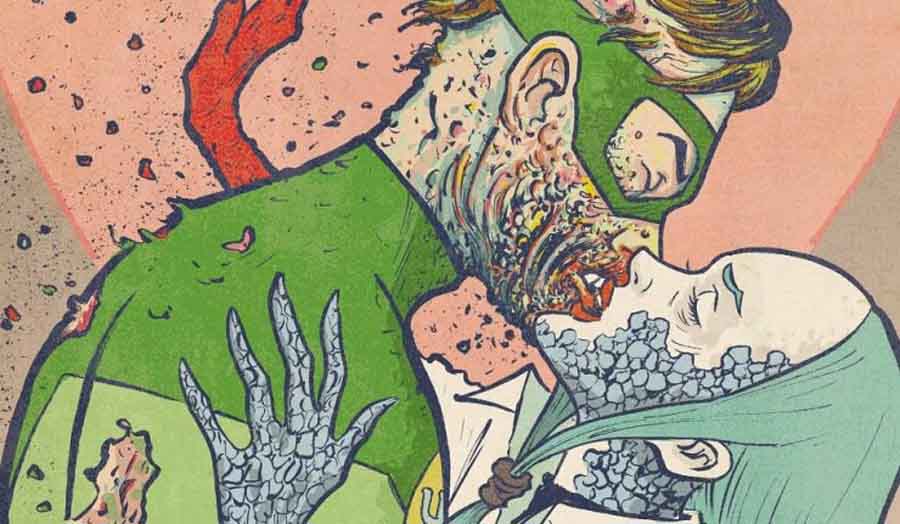My day job can sometimes make me feel less-than-human, grinding me down so I’m barely cognisant as I sleepwalk through a shift. That’s nothing compared to the plight Caroline, the superhero formerly known as Chrysalis, whose body was permanently altered for her work with secret government agency Alpha 13. Now she’s on administrative leave, sick of her malfunctioning shapeshifting body, and looking for a way out. Will she find one?
Cover by Sonny LiewWritten by Magdalene Visaggio
Illustrated by Sonny Liew
Colored by Chris Chuckry
Lettered by Todd KleinThe end really is nigh as Caroline confronts her destiny on two planes of existence, and the stakes could never be higher: eternal imprisonment, or total universal annihilation.
Transformed into a “Sumerian element goddess” capable of rearranging her atomic structure by the organisation, and now effectively immortal, Caroline finds herself kicked out of Alpha 13 following an “incident” where she lost control of her form and her powers. Now, she’s a superbeing without a cause. Which is where the “effectively” immortal bit comes in.
The first issue of “Eternity Girl” saw a vision of her dead arch-nemesis, Madame Atom, suggesting a way out of this purgatorial existence: by destroying all of space and time. This issue sifts through the emotional rubble following her failed attempt to effect this escape, and perhaps find an alternative solution to her seemingly-endless suffering.
In leaping off a building and detonating herself like an atom bomb, Caroline did learn something important. As she was being recombined into human form, she had another vision which revealed that while the corporeal form she so despises can be destroyed, she has lived many different lives in not only other bodies, but in many different art styles and genres. Unfortunately for her, every time she is reincarnated by some less-than-benevolent (creative) forces bigger than she can imagine. This might be a metaphor for something.
Caroline’s powers being on the fritz means she is unable to maintain a “normal” human form for more than a couple of hours. Before too long she reverts to an elemental patchwork person with blue hair, red clawed feet and crumbling chunks of stone running along her cheekbones. This is also a metaphor, and a powerful one at that, for the way mental illness (as well as work) erodes our sense of self. Speaking of symbolism, Madame Atom appears again as a reborn figure in Caroline’s head, where she takes the role of the intrusive thoughts of a depressive which constantly pokes and prods at their neuroses.
Conceptually, Liew and Visaggio still feel included in the nineties Vertigo vibe of the Young Animal imprint, despite “Eternity Girl” being an original creation unlike the line’s big names like “Doom Patrol” or “Shade, the Changing Woman” (née “Girl”). Its fourth-wall breaking — including Liew and colorist Chris Chuckry’s use of Ben-Day dots and Kirby Krackle during Caroline’s fantasy/dissociation sequences with Atom — and exploration of the mental health of superheroes is reminiscent of both “Doom Patrol,” as well as Chaz Truog and Grant Morrison’s “Animal Man.”
The way the latter is framed feels far more contemporary, however, and subsequently both more enlightened and better developed. This issue flits between Caroline’s heart-to-heart with fellow former Alpha 13 hero The Never Man, and with fellow elemental god-being Crash, both of whom offer variations on a theme with their advice on her situation. Sure, her existence may be without meaning or purpose, but that is no reason to despair.
Everyone is in the same absurdist boat, and most of them manage to stay afloat. Encouraging her to remain so, even amidst these choppy waters, and encouraging her not to sink herself on purpose (so to speak) while acknowledging her struggle is as progressive a discourse about practical self-care as you’re likely to get out of a postmodern superhero comic. That it also appears in the form of a huge trippy mandala presided over by a cosmic being in a tracksuit and afro holding some vinyl is truly inspired.
Liew recently won three Eisners for his graphic novel “The Art of Charlie Chan Hock Chye,” which employed no small amount of pastiche as it explored the different “styles” of the titular fictional comic artist over the course of several decades in the industry. His aping of sixties “Fourth World” books is similarly on point here (as were his nods to everyone from Charles Schulz to Jamie McKelvie last issue), in said mandala sequence and beyond.
Continued belowHis work during the “real world” portions are equally as arresting, his rough-hewn ink brush similar to Michael Walsh and exaggerated human forms no unlike Rob Guillory’s work on “Chew,” adding to the sense of dislocation and porous identities as the cast’s appearances subtly shift. Visaggio also skips between the different tones and realities with relative ease.
Equating the messines of comic book continuity, reboots and universe retoolings to the fractured psyche and volatile moods of mental illness is a provocative gambit that “Eternity Girl” nonetheless mostly pulls off. It may not be an entirely novel concept, but thanks to Visaggio’s sensitive and thoughtful handling of the subject, the strength of the characters and concept, and the collaboration of Liew and Chuckry, it never feels derivative.
Final Verdict: 8.3 – A crisis of infinite neuroses reaches a point of no return as “Eternity Girl” reaches its conceptual and artistic peak.




